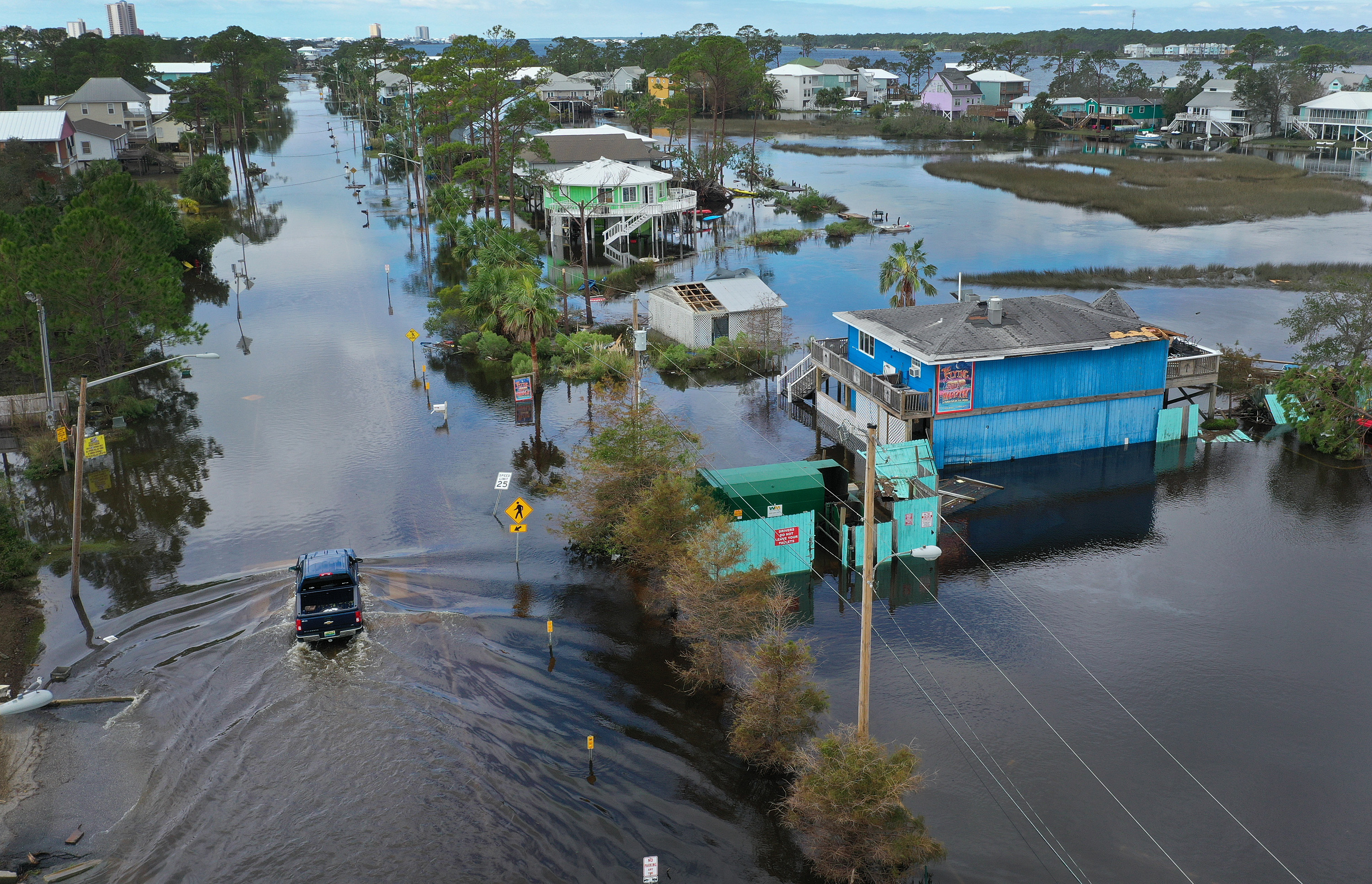MIAMI (CBSMiami/CNN) — A new report provides an alarming forecast for the US: Sea level will rise as much in the next 30 years as it did in the past 100 — increasing the frequency of high-tide flooding, pushing storm surge to the extreme and inundating vulnerable coastal infrastructure with saltwater.
The interagency report, led by the National Oceanic and Atmospheric Administration, shows how scientists are increasingly confident that US coasts will see another 10 to 12 inches of sea level rise by 2050.
READ MORE: Segregation Walls Are A Sad Reminder Of South Florida’s Jim Crow Past
The implications of that forecast are enormous.
“This report is a wake-up call for the US, but it’s a wake-up call with a silver lining,” NOAA chief Rick Spinrad said at a news conference on Tuesday. “It provides us with information needed to act now to best position ourselves for the future.”
The projected sea level rise will lead to a significant increase in the frequency of coastal flooding even on sunny days, scientists report. High-tide flood events in coastal cities — New York, Washington, Miami and others — have already doubled in annual frequency since 2000, turning what researchers say used to be a “rare event” into a “disruptive problem.”
Every inch of sea level rise also amplifies hurricane storm surge, coastal erosion and wetland loss — impacts which US coasts are already well familiar with.
“Decades ago, powerful storms were what typically caused coastal flooding,” NOAA reports. Today, due to sea level rise, “even common wind events and seasonal high tides regularly cause [high-tide flooding] within coastal communities, affecting homes and businesses, overloading stormwater and wastewater systems, infiltrating coastal groundwater aquifers with saltwater, and stressing coastal wetlands and estuarine ecosystems.”
The report didn’t set out to quantify how expensive these events would get in the future or how they would impact the economy. But Nicole LeBeof, the director of NOAA’s National Ocean Service, noted that millions of people live along the coast, and the rest rely on products that enter the country through ports on the coast.
“What I will say is that the magnitude of these impacts, direct and cascading, will be high,” LeBeof said at a news conference. “Forty percent of the US population lives within 60 miles of our coastlines. There will be highly variable impacts along those coastlines, but there’s no denying that a large portion of our economy and revenue and tax base are right there, front and center.”
Catastrophic sea level rise
Beyond 2050, the amount of sea level rise the US will experience is highly dependent on how much the world cuts fossil fuel emissions and limits global temperature rise.
Robert Kopp, a climate scientist at Rutgers University and co-author on the report, said sea level rise is becoming “increasingly sensitive to the amount of warming” the planet is experiencing.
For example, if global warming can be held to around 2 degrees above pre-industrial levels, NOAA estimates sea level rise in the US could be limited to 2 feet by the end of the century.
If temperatures are allowed to skyrocket, that forecast increases to 7 feet.
Part of the reason that range is so large is the uncertainty over future changes in the world’s largest ice sheets and how they will respond to rapid temperature rise. Faster melting of the Greenland or West Antarctic ice sheets could lead to catastrophic sea level rise in the United States by the end of the century.
Ben Hamlington, the sea level change team lead at NASA’s Jet Propulsion Laboratory and a co-author on the report, pointed to the potential collapse of Antarctica’s Thwaites glacier, also known as the “Doomsday glacier,” which scientists have said would lead to irreversible changes around the globe.
“We know where these different events could be triggered that would lead to rapid sea level rise, potentially,” Hamlington told CNN. “For right now, it’s important that we build in that uncertainty into our scenarios, that possibility of that happening, and that’s what we’ve done.”
William Sweet, oceanographer at NOAA’s National Ocean Service and the lead author on the report, said it’s important that this report gives decision-makers a range of plausible outcomes beyond 2050.
“Considering the knowns and unknowns are very important for certain types of decision making,” Sweet said. “Those that are very risk averse, who really can’t stand to be wrong, need to know these types of outcomes.”
Storm surge and ‘sunny day’ flooding
READ MORE: Fire Destroys Southwest Miami-Dade Home
The report serves as an update to the federal government’s 2017 sea level projections, using tide gauge and satellite observations combined with findings from the latest UN Intergovernmental Panel on Climate Change report to assess changes the country has already experienced and what is still to come.
The frequency of high-tide flooding has grown substantially in the past two decades, the report shows.
“We already are seeing once-rare tidal flooding events becoming increasingly frequent,” Kopp said. “So today along the Jersey Shore, flooding events that used to happen in the 1950s every year or two are now happening for several days a year on average.”
Twenty years ago, New York City would experience these “sunny day” flood events around five days a year; that frequency has now shot to 10 to 15 days.
In Miami, Florida, and Charleston, South Carolina, the frequency ballooned from two days in 2000 to five to 10 days in 2020. Researchers say these increases will continue to accelerate and spread to other coastal cities in the next few decades.
And sea level rise has already made tropical cyclones and hurricanes more deadly and more destructive. Storm surge — the water pushed onshore by a storm’s winds — can now spread farther inland because of higher baseline sea level.
A 2021 study, which Kopp also co-authored, found that sea level rise caused by the climate crisis added another $8 billion in flood damage to Superstorm Sandy’s impacts.
And as water piles up along the coast, rivers and streams that drain into the ocean can also be blocked, which forces water back upstream and extends the flooding farther inland. In 2021, Hurricane Ida’s powerful storm surge reversed the flow of the Mississippi River near New Orleans — something the US Geological Survey said was “extremely uncommon.”
All of these impacts worsen considerably with an additional foot of sea level rise through 2050.
“Today’s disruptive, sunny day high tide flooding is a growing problem in many communities, but that will become damaging flooding in 30 years time due to this increase of a foot or more in many East and Gulf Coast communities,” Sweet said. “So what is now disruptive will become outright damaging to our infrastructure and to our commerce unless action is taken.”
Limiting the worst
Even if the world can slash fossil fuel emissions in the coming decades and put a cap on global warming, the report emphasizes that the sea level rise projections are essentially locked in through 2050. Oceans will continue to climb due to the warming that humans have already caused.
And because tens of millions of people in the US already live in coastal areas at risk of flooding — with more people migrating to the coasts each year, partly due to ongoing land development — researchers say there will be a drastic rise in human exposure as well as the country’s critical infrastructure.
“We need to collectively as a country understand that there’s only so much sea level rise that can occur until real problems start surfacing in our communities,” Sweet said. “We need to recognize that it’s largely an elevation issue at this point when storm surge flooding becomes replaced by tidal flooding.”
But we can limit the worst long-term outcomes by reducing fossil fuel emissions, researchers say. The high-end forecasts for 2100 can be avoided if fossil fuel emissions are slashed.
“The next 30 years are pretty well in our headlights right now,” Sweet said. “We can give actionable information, but beyond that, emissions matter.”
“It’s collectively in our hands to determine what our future scenario will actually be.”
MORE NEWS: Scheck Hillel Community School Parent Accused Of Threatening To Burn Down School Over Mask Policy
The-CNN-Wire
™ & © 2022 Cable News Network, Inc., a WarnerMedia Company. All rights reserved.



